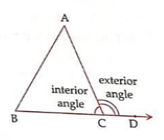CLASS-6
ANGLE - INTERNAL & EXTERNAL ANGLE
INTERNAL & EXTERNAL ANGLE -
In geometry, angles are formed by two rays with a common endpoint called the vertex. When considering triangles, there are internal angles and external angles.
1. Internal Angles:-
Internal angles of a triangle are the angles formed inside the triangle by its three sides.
The sum of all internal angles in any triangle is always equal to 180 degrees. This is known as the Triangle Sum Theorem.
Each internal angle is formed by two sides of the triangle, and the measure of the angle depends on the lengths of these sides and the shape of the triangle.
An internal angle is the angle formed between two adjacent sides or lines on the inside of a polygon.
For a polygon with n sides, the sum of all internal angles is given by the formula: (n − 2) × 180∘.
The measure of each internal angle in a regular polygon (where all sides and angles are equal) is given by:
Sum of Internal Angles
Internal Angle = --------------------------
n
2. External Angles:-
External angles of a triangle are the angles formed outside the triangle by extending one of its sides.
The external angle and the internal angle adjacent to it (on the same side of the transversal) always add up to 180 degrees. This is known as the Exterior Angle Theorem.
For example, if you extend one side of a triangle, the angle formed outside the triangle is the external angle, and the adjacent internal angle (inside the triangle) will add up to 180 degrees with it.
An external angle is the angle formed between one side of a polygon and the extension of an adjacent side on the outside of the polygon.
The measure of each external angle in a polygon is supplementary to the measure of its internal angle. In other words -
External Angle + Internal Angle = 180∘.
For a regular polygon, the measure of each external angle is given by:
360∘
External Angle = --------- (where n is the number of sides.)
n

- In the triangle ABC, angles A, B, and C are internal angles.
- If you extend side BC, you can form an external angle at point D (let's call it angle X).
- The sum of angle X and angle Y (internal angle) will be 180 degrees.
Understanding internal and external angles is essential when working with triangles and can help in solving various geometric problems and theorems related to triangles.